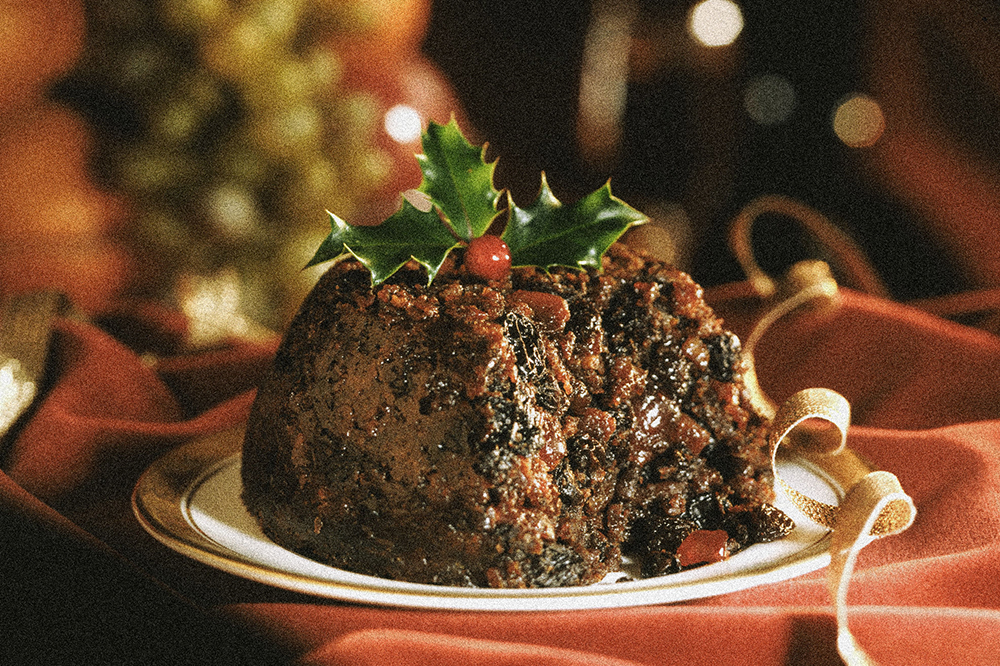I used to be a Christmas pudding denier. I couldn’t see the attraction of a dense pudding made mostly of currants; frankly, I’d rather have a trifle. Of course, I was wrong: I was judging Christmas pudding by poor examples, those that sat on the edge of a Christmas lunch tray at school or were half-heartedly doled out by other pudding sceptics (I’m looking at you, Mother).
My conversion came about thanks to a party – a Christmas pudding party. Not a party for eating Christmas party but rather one where the guests made Christmas puddings. It was hosted by my friend Kate and I went along out of love for her, rather than love for the pud.
Under Kate’s keen eye, and following her great-granny’s recipe, we creamed kilos of butter and sugar in a big plastic tub. We stood around tables grating carrots and apples; we chopped dried figs, glacé cherries and candied peel; we cracked eggs and sloshed booze. At the end, the mixture was divided between our various bowls and we each left with three handsome Christmas puddings, ready to steam.
I remained unsure but once home, I duly steamed my puddings, watching my windows steam up until it looked as if it were raining inside my house. The result was a softer pudding than I expected, with layers of flavour and texture, delicately spiced and complex, and irresistible. I was a convert.
Because I can never do anything by halves, I will now take Christmas pudding whenever it’s offered. I’ve eaten Christmas pudding in August, I’ve eaten it after lasagne and I’m eating Christmas pudding right now. I am a Christmas pudding truther: it is among our very finest puddings, and shouldn’t be reserved for one day a year. Christmas pudding is not just for Christmas.
My pudding is based on Kate’s, but with a handful of tweaks of my own. The ingredients list and instructions look intimidating, but it’s just a host of dried fruit steeped in sherry and then brought together into a standard cake mix. Creaming the butter and sugar together keeps the pudding light, and the grated apple and carrot keep it moist. The seeds in the dried figs bring tiny little bursts of texture, and the flaked almonds crinkle and crunch as you eat. A heavy hand with the candied fruit and a couple of spoonfuls of bitter orange marmalade make sure it isn’t too sweet. You can use whichever dark, festive booze takes your fancy, but I borrow from Nigella and plump for a generous splash of Pedro Ximénez, the sweetest and most complex of the sherry family – Christmas in a bottle.
My darkest secret is that, other than when my guests are watching on Christmas Day, I don’t re-steam my pudding, I microwave it. Steamed puddings don’t reheat well in an oven, but a microwave stops them drying out. There is, however, another way too because though Christmas pudding is great on Christmas Day, it is even better on Boxing Day or the day after, sliced into thick slabs and fried in butter. As the pudding fries, it becomes defined and glossy: dots of figs and halves of cherries come to life like hidden jewels and a crust will form, caramelised from the hot butter and sugar. I like to do this with the fanciest, saltiest butter I have, but brandy butter is fantastic too, and gives the pudding a butterscotch coating.
Serves: 6-8 (1 x 1kg pudding)
Hands-on time: 30 minutes, plus steeping
Cooking time: 3 hours steaming (in advance), 2 hours steaming (on the day)
- 75g prunes, stoned and chopped
- 80g dried soft figs, chopped
- 50g glacé cherries, halved
- 75g dates, stoned and chopped
- 100g mixed dried fruit
- 1 apple and 1 carrot, peeled and grated
- 2 tbsp bitter orange marmalade
- 1 tbsp mixed spice
- ½ tsp ground nutmeg
- ½ tsp ground cinnamon
- 1 tsp golden syrup
- 100ml Pedro Ximénez (or strong alcohol of your choice)
- 115g soft brown sugar
- 115g butter
- 2 eggs
- ½ tsp salt
- 110g self-raising flour
- 65g breadcrumbs
- 40g flaked almonds
- Mix all the dried fruit, grated carrot and apple, marmalade, spices and syrup together with the Pedro Ximénez in a saucepan, stir, bring to a simmer, turn off the heat and leave for an hour.
- Cream together the butter and sugar until pale brown and fluffy. Add the eggs, one at a time, completely combining the first with the mixture before adding the second. Stir through the flour, salt and breadcrumbs. Stir in the almonds, soaked fruit and any residual Pedro Ximénez. Put a small disc of baking paper in the base of a 20cm pudding basin and spoon the mixture on top.
- Place a sheet of baking paper on top of a sheet of foil, and fold both along the middle to create a pleat. Place this over the top of the bowl, centring the pleat. Tie tightly with string around the rim of the basin. Alternatively, you can use heat-safe clingfilm over the top of the covered basin, wrapping it around twice to completely cover the bowl.
- To steam, place a tea towel in the bottom of a large pan. Fill halfway with water, and bring to a simmer. Put the pudding in the pan, and cover the pan with a lid. Steam for three hours, keeping an eye on the water level to make sure the pan doesn’t boil dry.
- When your pudding is cooked, remove the foil and greaseproof paper and leave it to cool and then dry out. Once the pudding is completely dry, place a new disc of greaseproof paper directly on top of it, cover it with clingfilm and store it in a cool dry place.
- When you’re ready to eat the pudding, steam it in the same manner for 2½ hours. Once the time is up, remove the covering and run a knife around the edge of the basin: the pudding should slip out easily.







Comments